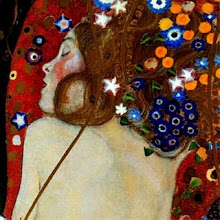Vanilla planiflora
Image Credit : Everglades National Park (Public Domain-USGov)
Well, surprise, surprise... this isn't a palate cleanser! Yeah, I know it's bait and switch... This one is about food, fair trade, sustainable farming and deforestation.
So this morning, I settled down to have my coffee and check email and my browser window opened on CNN as always and what do I see but an article titled "Is world's largest vanilla market on verge of collapse?" Two of my three kids are still heavily into vanilla and the oldest is a chef, and to top it off, just looking at that title gave me that whole not sustainable/fair trade farming feel, so I just had to read more.
Vanilla flavoring is derived from the fruit of the
Vanilla planiflora orchid. It is the
most expensive spice after saffron, with which it shares a highly labor intensive harvesting method. While the main component of vanilla scent is vanillin,
some 171 other aromatic components are found in vanilla beans. Imitation vanilla relies solely on vanillin to achieve its scent and flavor. Subtle components like piperonal are not present in imitation vanilla extracts.
From the farming end, production, i.e. propagation and pre-planting requirements, of vanilla is complicated, requiring a specific set of conditions to support growth. While the plant itself thrives in Madagascar, with no native bees to do the work of pollination, each flower must be pollinated by hand, an astonishing amount of work when you consider their production level. And the harvesting of the bean is also done entirely by hand, then requires further intensive labor to prepare the bean for sale.
Vanilla is considered a volatile market commodity. Due to lower costs of imitation vanilla, which can be produced from lignin wastes from paper production, the market for real vanilla has dropped markedly in recent times. Although the UN's International Fund for Agriculture Development still offers vanilla growing assistance, the IFAD also is the source of information in CNN's article showing that the drop in the cost of a kilo of vanilla bean has dropped from $500 USD in 2003 to an abysmal $25-30 USD in 2010. With wages in the range of $1-2 USD a day, the farmers growing vanilla can barely survive. In fact, Madagascar is one of the poorest countries in the world. All you have to do is look at that wage and you really don't need the UN cost of living report for Madagascar to see that vanilla farming is simply not sustainable if the farmer wants to eat and have some shelter and clothing to boot. Not the fair trade model by a long shot.
With over 5% of the world's plant population, and 80-85% indigenous solely to Madagascar, the Malagasy people have struggled to survive and have damaged their natural resources with extensive deforestation (primarily for coffee production, but vanilla, which is grown largely on the northeast side of the island, also has very specific growing conditions, as mentioned above. Mining has also take a toll. Ecotourism is starting to take some precedence in the Malagasy political goals. Clearly, as the CNN article suggests, production of vanilla is likely on the verge of collapse. Rather than raising the price of the commodity, it's likely to make images like these, in which precious vanilla beans are merely decorative, a thing of the past.
(Attribution Unknown)
http://www.amountainofcrushedice.com/?p=3811
While you and I might want to go out and buy real vanilla extract and vanilla beans, it may sadly be too late for Malagasy farmers if the CNN article is any indication.
Where does your food come from? Does the farmer who grows it make a living wage?
© Bright Nepenthe, 2010

























I'm shocked that the market for the finest vanilla has virtually collapsed; I honestly had no idea this was happening. :(
ReplyDeleteIt's depressing that so many people have opted to go with imitation flavoring. (To say that the fake stuff pales in comparison is an understatement of epic proportions.)
But most of all, what an awful state of affairs for the people who've devoted their lives to its production; I can't imagine what they'll do now...
GK, indeed it's so depressing. In the depressed economy it's also likely to be increasingly common that specialized crops like saffron, vanilla and also artisanal products are going to be sidelined by cheaper and imitation substitutes. And I'm right there with you on their being no replacement for the real flavoring which is just so complex and delightful.
ReplyDelete